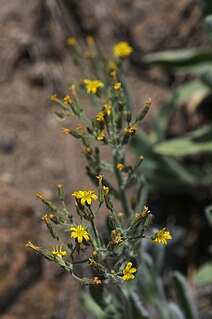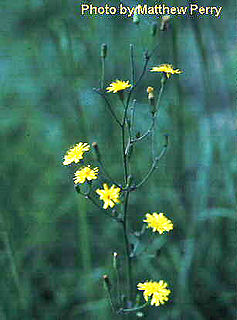
Hieracium , known by the common name hawkweed and classically as hierakion, is a genus of flowering plant in the family Asteraceae, and closely related to dandelion (Taraxacum), chicory (Cichorium), prickly lettuce (Lactuca) and sow thistle (Sonchus), which are part of the tribe Cichorieae. Hawkweeds, with their 10,000+ recorded species and subspecies, do their part to make Asteraceae the second largest family of flowering plants. Some botanists group all these species or subspecies into approximately 800 accepted species, while others prefer to accept several thousand species. Since most hawkweeds reproduce exclusively asexually by means of seeds that are genetically identical to their mother plant, clones or populations that consist of genetically identical plants are formed and some botanists prefer to accept these clones as good species whereas others try to group them into a few hundred more broadly defined species. What is here treated as the single genus Hieracium is now treated by most European experts as two different genera, Hieracium and Pilosella, with species such as Hieracium pilosella, Hieracium floribundum and Hieracium aurantiacum referred to the latter genus. Many members of the genus Pilosella reproduce both by stolons and by seeds, whereas true Hieracium species reproduce only by seeds. In Pilosella, many individual plants are capable of forming both normal sexual and asexual (apomictic) seeds, whereas individual plants of Hieracium only produce one kind of seeds. Another difference is that all species of Pilosella have leaves with smooth (entire) margins whereas most species of Hieracium have distinctly dentate to deeply cut or divided leaves.
A dry roadside dotted with small, ¾ inch red orange flowers, interspersed with very similar yellow ones, and often the white of daisies, is a good sign that you are in Hawkweed country.

Pilosella horrida, known as the prickly hawkweed or shaggy hawkweed, gets its name from the long, dense, shaggy white to brown hairs (trichomes) which cover all of the plant parts of this plant species. The species is native to Oregon, California, and Nevada in the western United States.

Carphochaete is a genus of North American flowering plants in the family Asteraceae. They are native to Mexico and the southwestern United States. They are known commonly as bristleheads.

Eriophyllum pringlei is a North American species of flowering plant in the family Asteraceae known by the common name Pringle's woolly sunflower. It is native to the southwestern United States and northern Mexico, where it grows in several types of desert, canyon, and hillside habitat, such as chaparral and sagebrush.

Symphyotrichum pilosum, commonly called hairy white oldfield aster or frost aster, is a flowering plant in the family Asteraceae native to central and eastern North America. It is a perennial, herbaceous plant that may reach 20 to 120 centimeters tall. Its flowers have white ray florets and yellow disk florets.

Raillardella pringlei is an uncommon species of flowering plant in the family Asteraceae known by the common name showy raillardella. It is endemic to the southern Klamath Ranges of northern California, where it grows in moist forest habitat on serpentine soils. It is a rhizomatous perennial herb growing in a clump of rosetted basal leaves. The leaves are linear to lance-shaped with smooth or faintly toothed edges, up to 15 centimeters long, and mostly hairless. The plant produces an inflorescence generally 25 centimeters to half a meter tall consisting of a solitary flower head or an array of up to three heads. The head is bell-shaped, sometimes widely so. It contains many orange to red-orange disc florets each about a centimeter long, and a fringe of several orange or reddish ray florets each up to 2 centimeters in length. The fruit is a long, narrow achene which may be 2 centimeters in length including its pappus of plumelike bristles.
Brickellia pringlei, or Pringle's brickellbush, is a North American species of flowering plants in the family Asteraceae. It is native to northern Mexico and the southwestern United States.
Brickellia rusbyi, the stinking brickellbush, is a North American species of flowering plants in the family Asteraceae. It is native to northern Mexico and the southwestern United States.
Flourensia pringlei, common name Pringle's tarwort, is a species of flowering plant in the family Asteraceae. It is native to the States of Chihuahua and Durango in northern Mexico, the range extending just barely over the international border into Hidalgo County in southwestern New Mexico.
Hieracium bolanderi or Bolander's hawkweed is a North American plant species in the tribe Cichorieae within the family Asteraceae. It is found primarily in the mountains of western Oregon and northern California in the United States, although there are reports of the species farther south in the San Bernardino Mountains in southern California and also in Baja California in Mexico.
Hieracium crepidispermum is a North American plant species in the tribe Cichorieae within the family Asteraceae. It is widespread across much of Mexico and found also in the US states of Arizona and New Mexico.

Hieracium gronovii or queendevil is a North American plant species in the tribe Cichorieae within the family Asteraceae. It is common and widespread across much of the continent from Ontario south as far as Florida, the Dominican Republic, and Panamá.
Hieracium longiberbe, known by the common name longbeard hawkweed, is a rare North American plant species in the tribe Cichorieae within the family Asteraceae It has been found only in the Columbia River Gorge along the border between the states of Washington and Oregon in the northwestern United States.

Hieracium longipilum, the hairy hawkweed, is a North American plant species in the tribe Cichorieae within the family Asteraceae. It is widespread across much of central Canada and the central United States from Ontario south to Texas and Louisiana. There are old reports of the species growing in Québec, but apparently does not grow there now.

Hieracium megacephalum, the coastal plain hawkweed, is a North American plant species in the tribe Cichorieae within the family Asteraceae. It grows only in the southeastern United States, in Georgia, Florida, and the Carolinas.
Hieracium nudicaule is a North American plant species in the tribe Cichorieae within the family Asteraceae. It grows only in the western United States, primarily in California and Oregon, though with a few populations in Washington and northern Idaho.

Hieracium paniculatum, the Allegheny hawkweed, is a North American plant species in the tribe Cichorieae within the family Asteraceae. It grows only in the eastern United States and eastern Canada, from Nova Scotia west to Ontario, Michigan, and Indiana south as far as Georgia.
Hieracium robinsonii, or Robinson's hawkweed, is a North American plant species in the tribe Cichorieae within the family Asteraceae. It is native to eastern Canada and the northeastern United States. There are reports of it formerly growing in Newfoundland, but it does not appear to grow there now.

Hieracium scabrum, the rough hawkweed, is a North American plant species in the tribe Cichorieae within the family Asteraceae. It is native to eastern and central Canada and the eastern and central United States from Nova Scotia west to Ontario, Minnesota, and Kansas south as far as Georgia and Oklahoma.
Pilosella friesii – not to be confused with the European P. schultesii – is a North American plant species in the tribe Cichorieae within the family Asteraceae. It is widespread across much of Mexico with a few populations in Guatemala and western Texas.










